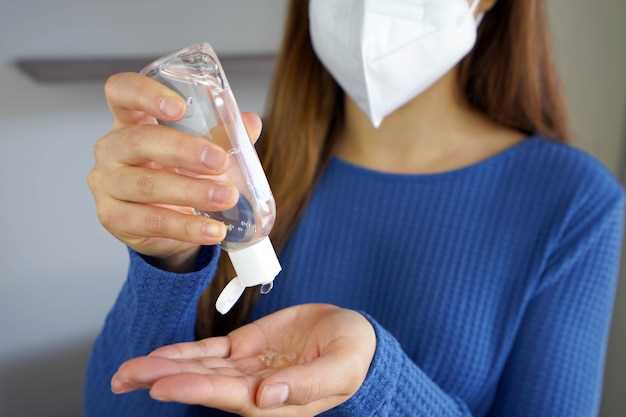
Are you dealing with infections? If so, metronidazole gel could be the solution you’ve been searching for. This powerful topical treatment is specially formulated to target a wide range of infections, providing fast and effective relief.
From bacterial vaginosis to rosacea, metronidazole gel is versatile and proven to combat a variety of infectious conditions. Say goodbye to discomfort and hello to clear, healthy skin with metronidazole gel.
Treatment of Bacterial Vaginosis

Metronidazole gel is commonly used for the treatment of bacterial vaginosis, a common vaginal infection characterized by an imbalance in the vaginal flora. Bacterial vaginosis can cause symptoms such as unusual vaginal discharge, itching, and a fishy odor.
Metronidazole gel works by targeting the anaerobic bacteria responsible for bacterial vaginosis, helping to restore the natural balance of bacteria in the vagina. The gel formulation allows for easy application directly to the affected area, providing targeted treatment.
How to Use:
It is important to follow the instructions provided by your healthcare provider when using metronidazole gel for the treatment of bacterial vaginosis. Typically, the gel is applied intravaginally once or twice daily for a certain period of time as prescribed.
Benefits:
Using metronidazole gel for bacterial vaginosis treatment offers localized therapy with minimal systemic absorption, reducing the risk of side effects associated with oral medications. The targeted application of the gel ensures effective treatment of the infection at the source.
| Summary: | Metronidazole gel is an effective and convenient treatment option for bacterial vaginosis, offering targeted therapy with minimal systemic effects. Consult your healthcare provider for personalized treatment recommendations. |
|---|
Metronidazole Gel Overview
Metronidazole gel is a topical medication that is commonly used to treat a variety of infections, including trichomoniasis. It is an antibiotic that works by stopping the growth of bacteria and protozoa.
When applied to the affected area, metronidazole gel is absorbed into the skin and works to eliminate the infection. It is particularly effective against trichomoniasis, a sexually transmitted infection caused by the parasite Trichomonas vaginalis.
How Metronidazole Gel Works
Metronidazole gel works by interfering with the DNA of the bacteria or parasite, preventing them from reproducing and spreading. This helps to eliminate the infection and relieve symptoms such as itching, discharge, and inflammation.
Effectiveness Against Trichomoniasis
Metronidazole gel is highly effective in treating trichomoniasis, a common sexually transmitted infection caused by the parasite Trichomonas vaginalis. Trichomoniasis can result in symptoms such as vaginal discharge, itching, and discomfort during urination.
When applied topically, metronidazole gel is able to penetrate the tissues and reach the site of infection, where it can target and eliminate the parasite responsible for trichomoniasis. This targeted approach helps to quickly reduce the symptoms and clear the infection.
Benefits of using metronidazole gel for trichomoniasis include:
- Rapid relief of symptoms
- High success rate in clearing the infection
- Convenient topical application
| Pros | Cons |
|---|---|
| Effective against trichomoniasis | Possible mild skin irritation |
| Easy to use | May cause temporary discomfort |
Overall, metronidazole gel is a reliable treatment option for trichomoniasis that offers quick symptom relief and effective clearance of the infection.
Use in Rosacea Management
Rosacea is a common skin condition characterized by redness, flushing, and sometimes pimples or bumps on the face. Metronidazole gel has been shown to be an effective treatment for managing the symptoms of rosacea. When applied topically, metronidazole works to reduce inflammation and redness, helping to improve the overall appearance of the skin.
How does Metronidazole Gel Help with Rosacea?

Metronidazole gel has anti-inflammatory and antimicrobial properties that make it a beneficial treatment for rosacea. By reducing inflammation and killing bacteria on the skin, metronidazole can help decrease redness and minimize the severity of rosacea flare-ups. Regular use of metronidazole gel as directed by your healthcare provider can lead to significant improvement in the appearance of rosacea-affected skin.
It is important to note that metronidazole gel should be used consistently and as prescribed to see the best results. It is usually applied once or twice daily to clean, dry skin. Be sure to follow your healthcare provider’s instructions for optimal outcome.
Side Effects and Precautions
Metronidazole gel may cause some side effects, although not everyone will experience them. Common side effects may include:
| 1. | Minor skin irritation such as burning, redness, or itching |
| 2. | Dryness or peeling of the skin |
| 3. | Unpleasant taste in the mouth |
| 4. | Discharge or leakage from the vagina (for vaginal metronidazole gel) |
If any of these side effects persist or worsen, it’s important to consult your healthcare provider. Additionally, it’s crucial to follow the prescribed dosage and application instructions to minimize the risk of adverse effects.
Precautions to consider when using metronidazole gel include:
| 1. | Avoid contact with the eyes and mouth. In case of accidental contact, rinse thoroughly with water. |
| 2. | Avoid using metronidazole gel on broken or irritated skin. |
| 3. | Consult your healthcare provider if you have a history of allergies to metronidazole or other medications. |
| 4. | Inform your doctor about any existing medical conditions, especially if you are pregnant or breastfeeding. |
Remember to store metronidazole gel at room temperature, away from direct sunlight and moisture, and keep it out of reach of children.
Comparison with Oral Metronidazole
Metronidazole gel and oral metronidazole are both effective in treating various infections, but they differ in their mode of administration and potential side effects. The gel form is typically applied topically to the affected area, such as the skin or vagina, whereas oral metronidazole is taken by mouth and absorbed into the bloodstream.
While both forms can be used to treat bacterial infections, metronidazole gel is often preferred for localized infections, such as skin conditions like rosacea or vaginal infections like bacterial vaginosis. Oral metronidazole may be more suitable for systemic infections, such as certain types of parasites or infections in the gastrointestinal tract.
